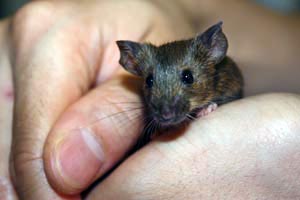 We understand that animal research is necessary to the advancement of scientific and medical knowledge. We support it and we have participated in it; however, we cannot help but feel sorry for the innocent creatures who unknowingly give their bodies and lives to educating and helping others. After working in Vaccarino Lab at the Yale Child Study Center for three years of college and the summer afterwards, Kathy longed to save a couple of the many mice who are born, raised, altered, and potentially sacrificed for research. When she left Yale, her labmate kindly offered two young mice to share her home in New York City.
We understand that animal research is necessary to the advancement of scientific and medical knowledge. We support it and we have participated in it; however, we cannot help but feel sorry for the innocent creatures who unknowingly give their bodies and lives to educating and helping others. After working in Vaccarino Lab at the Yale Child Study Center for three years of college and the summer afterwards, Kathy longed to save a couple of the many mice who are born, raised, altered, and potentially sacrificed for research. When she left Yale, her labmate kindly offered two young mice to share her home in New York City.
The mice are unnamed and are only referred to as Mr. Mousie and Mr. Mousie, even though they are both female. One of the most pleasurable aspects of raising mice is simply observing them. Their play and their interactions are hugely entertaining. At the beginning, the only way to tell them apart was by a clipped ear on one mouse. This mouse is now clearly the dominant mouse – she takes the food from the other’s hands and is much larger.
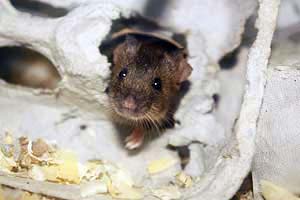 Our mice eat fortified pellet food with occasional supplemental treats like fresh vegetables, unsalted sunflower seeds, and oatmeal (they love oatmeal!). We clean out their bedding of shaved wood about once a week. When their cage is cleaned, we place them in a warm washcloth and rub gently to clean them (though this is really not necessary as they groom themselves). Afterwards, they run around our apartment in a hamster ball.
Our mice eat fortified pellet food with occasional supplemental treats like fresh vegetables, unsalted sunflower seeds, and oatmeal (they love oatmeal!). We clean out their bedding of shaved wood about once a week. When their cage is cleaned, we place them in a warm washcloth and rub gently to clean them (though this is really not necessary as they groom themselves). Afterwards, they run around our apartment in a hamster ball.
We also routinely change the objects and toys in the cage. After all, Kathy’s project was about the beneficial effects of environmental enrichment. These mice get lots of exercise doing “monkey bars” on the cage and on their running wheel. Their toys include a hanging bell (intended for birds), tree branches, plastic tunnels, egg cartons, and toilet paper rolls. Kathy’s coworkers at Pediatric Ophthalmic Consultants have been wonderful at saving potential supplies! The compressed cardboard that comes in toner boxes is especially fun for our mice. Of course, all recycled toys are ink-free.
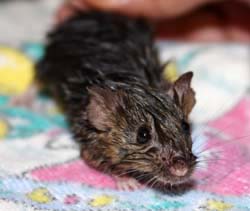 Surprisingly, our mice are very clean. They often groom each other and they usually even have a “pee corner” (too much information?). They do not smell though their not smelling obviously hinges upon the frequency that we clean the cage. They are not loud, as long as we oil their running wheel. They are great pets. Mr. Mousie and Mr. Mousie are now loved parts of our family, and we are thrilled to have their company. Mice are wonderful pets and we hope you consider raising a couple of your own. The pleasure we get from caring for and watching these two mice grow reminds us of the many creatures who have contributed to the discovery of medical knowledge. Even though we support the use of animals for research, we also have a great respect for all little lives that are involved.
Surprisingly, our mice are very clean. They often groom each other and they usually even have a “pee corner” (too much information?). They do not smell though their not smelling obviously hinges upon the frequency that we clean the cage. They are not loud, as long as we oil their running wheel. They are great pets. Mr. Mousie and Mr. Mousie are now loved parts of our family, and we are thrilled to have their company. Mice are wonderful pets and we hope you consider raising a couple of your own. The pleasure we get from caring for and watching these two mice grow reminds us of the many creatures who have contributed to the discovery of medical knowledge. Even though we support the use of animals for research, we also have a great respect for all little lives that are involved.
In memoriam: Our beloved mice both passed away peacefully in their very old age. They are safely buried at the East River Espanade in Manhattan, New York City and rest eternally in peace. In the future, we hope to raise more rescued lab mice as a thank-you to the many who have donated their lives to science.

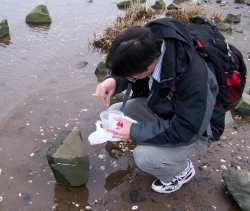 From 2006 to 2007, Kathy coordinated the Teen Docents Program for local high-school students at the nonprofit organization
From 2006 to 2007, Kathy coordinated the Teen Docents Program for local high-school students at the nonprofit organization 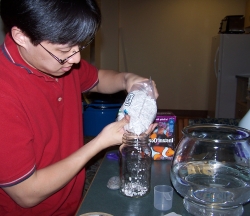 After having such fun with the teens, Kathy begged Silas to go back to Long Wharf so that they could catch a few of these crabbies as pets. He was reluctant at first: What would these crabs eat? Where would they live? How do we take care of them? Can they survive indoors? Do they smell? After completing thorough research (or as thorough as we could manage, since there aren’t many web pages about raising Japanese shore crabs as pets), we decided that crabbies may be a good idea. And so we embarked on the Crabbie Expedition of 2007. We weathered the coldest, windiest day possible to turn over rock after rock in search of the scurrying creatures. At the end of the day, we took them back to Silas’ place in a tupperware container. Oddly enough, we had a seafood dinner on our way home but no worries – we both refrained from crab.
After having such fun with the teens, Kathy begged Silas to go back to Long Wharf so that they could catch a few of these crabbies as pets. He was reluctant at first: What would these crabs eat? Where would they live? How do we take care of them? Can they survive indoors? Do they smell? After completing thorough research (or as thorough as we could manage, since there aren’t many web pages about raising Japanese shore crabs as pets), we decided that crabbies may be a good idea. And so we embarked on the Crabbie Expedition of 2007. We weathered the coldest, windiest day possible to turn over rock after rock in search of the scurrying creatures. At the end of the day, we took them back to Silas’ place in a tupperware container. Oddly enough, we had a seafood dinner on our way home but no worries – we both refrained from crab.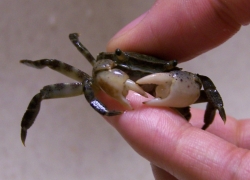 Our very first crabbies were tiny! In fact, one was no larger than the word “crab” in 12pt. Times New Roman font. But they were our first ones and we were very excited to have them. After we were more comfortable in our ability as adoptive parents to the crabbies, we set the smaller ones free to thrive and grow in the rocky waters, and we brought home larger crabs to care for. The bodies of these were slightly smaller than a quarter, as you can see from the image.
Our very first crabbies were tiny! In fact, one was no larger than the word “crab” in 12pt. Times New Roman font. But they were our first ones and we were very excited to have them. After we were more comfortable in our ability as adoptive parents to the crabbies, we set the smaller ones free to thrive and grow in the rocky waters, and we brought home larger crabs to care for. The bodies of these were slightly smaller than a quarter, as you can see from the image.

